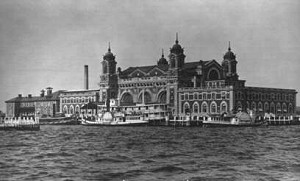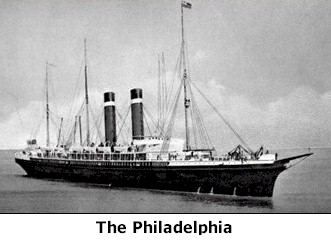|
Emigration to the United States - The Journey and Entry at Ellis Island
The U.S. federal immigration facility at Ellis Island was open from 1892 to 1954, and during those years 12 million people passed
through its halls at an average rate of 5,000 newcomers per day, seven days a week. Forty percent of Americans can trace their
ancestry to at least one relative who was processed through Ellis Island. During the years 1880-1930, 4.6 million Italians emigrated
to the United States, the single largest ethnic group among all U.S. immigrants and nearly one third of the population of Italy. Of these,
some 80% were peasant farmers from "il Mezzogiorno," or southern Italy. After its opening in 1892, nearly all entered the
U.S. through Ellis Island.
 Immigrants who arrived in the U.S. before 1892 were processed through Castle Clinton in Battery Park, New York. Between 1855
and 1892 more than 8 million newcomers were received there. The building was constructed between 1808 and 1811 as a
sandstone fort intended to defend New York Harbor against the British. Named after New York's mayor (later governor) DeWitt
Clinton, the fort was vacated by the army in 1821. After being used for several other purposes the building was converted and served
as the country's first national immigration center.
Immigrants who arrived in the U.S. before 1892 were processed through Castle Clinton in Battery Park, New York. Between 1855
and 1892 more than 8 million newcomers were received there. The building was constructed between 1808 and 1811 as a
sandstone fort intended to defend New York Harbor against the British. Named after New York's mayor (later governor) DeWitt
Clinton, the fort was vacated by the army in 1821. After being used for several other purposes the building was converted and served
as the country's first national immigration center.
By the 1890's steam-powered ships had replaced sailing vessels and cut the time to make the Atlantic Ocean crossing from three
months to two weeks. These ships could accommodate as many as two thousand passengers, most of whom were booked in Third
Class, or "steerage" - a noisy, smoky area near the ship's steering mechanism. The long and narrow compartments in steerage were
divided into separate areas for single men, single women, and families. They were jammed with metal-framed sleeping berths three
bunks high. There was very little, if any, privacy, and the lack of adequate toilet facilities made it difficult to keep clean. By 1910,
many ships had replaced steerage with four and six-berth Third Class cabins. These newer ships served meals in dining rooms with
long tables set with dishes and utensils. The Italian ship lines served pasta and wine, but not all ships catered to ethnic or religious
tastes.
When the immigrants landed in America, the First and Second Class passengers would be inspected and cleared to land by
immigration officials who came on board the ship from the Quarantine Station. These passengers underwent a cursory inspection
aboard ship - the theory being that if people could afford to purchase a first or second class ticket, they were less likely to become
a public charge. The U.S. government felt that more affluent passengers would not end up in institutions, hospitals or become a
burden to the state.
 Third Class passengers, however, would board a ferry or barge to Ellis Island for inspection. On each immigrant was pinned a number
tag giving the manifest page and line number on which their name appeared. If the immigrant's papers were in order and they were in
reasonably good health, the inspection process would last approximately three to five hours. The inspections took place in the Registry
Room, where doctors would briefly scan the immigrant for obvious physical ailments. Doctors at Ellis Island soon became very adept
at conducting these "six second physicals." By 1916, it was said that a doctor could identify many medical conditions (ranging
from anemia to goiter to varicose veins) just by glancing at an immigrant. Next the newcomers lined up in front of the "eye man,"
who used a buttonhook to turn eyelids up as he looked for trachoma and other contagious eye diseases. Trachoma, a highly
contagious ailment, was, and still remains, grounds for refusal of entry.
Third Class passengers, however, would board a ferry or barge to Ellis Island for inspection. On each immigrant was pinned a number
tag giving the manifest page and line number on which their name appeared. If the immigrant's papers were in order and they were in
reasonably good health, the inspection process would last approximately three to five hours. The inspections took place in the Registry
Room, where doctors would briefly scan the immigrant for obvious physical ailments. Doctors at Ellis Island soon became very adept
at conducting these "six second physicals." By 1916, it was said that a doctor could identify many medical conditions (ranging
from anemia to goiter to varicose veins) just by glancing at an immigrant. Next the newcomers lined up in front of the "eye man,"
who used a buttonhook to turn eyelids up as he looked for trachoma and other contagious eye diseases. Trachoma, a highly
contagious ailment, was, and still remains, grounds for refusal of entry.
A person appearing to be sick or suffering from a contagious disease was marked with blue chalk, indicating that they should report
to the medical examination rooms for further scrutiny: an E for eye problems, an H for heart, L for lameness, SC for scalp, X for mental
disease, and so on. Some were taken to the Ellis Island Hospital for observation and care. After recovering, they could proceed with
the legal inspection.
The ship's manifest log contained the immigrant's name and his/her answers to twenty-nine questions (the actual number of questions
varied over time, with more questions added as the years progressed). This document was used by the legal inspectors at Ellis Island
to cross-examine the immigrant during the legal inspection, to verify that the ship's manifest information agreed with what the
immigrant stated to them or what they observed. The two U.S. government agencies responsible for processing immigrants at Ellis
Island were the U.S. Public Health Service and the U.S. Bureau of Immigration (now called the Immigration and Naturalization Service,
or INS).
Last came the "Stairs of Separation," where people separated depending on the direction they were headed. Those who failed to pass
the tests at the immigration office were sent back to Italy, usually because a doctor had diagnosed a contagious disease that would
endanger the public health or if a legal inspector thought the immigrant was likely to become a public charge or an illegal
contract laborer. Recognizing that pursuit of profits might lead steamship companies to encourage inadmissable aliens to travel to the
United States, Congress included provisions in its 1893 immigration law requiring shipping companies to conduct preliminary health
and legal inspections at the port of embarkation or on board ship, and to pay for the return trips of inadmissible passengers.
Approximately 250,000 Italians were denied entry at Ellis Island.
back to top
<<< Back to the main Emigration page
|


 Immigrants who arrived in the U.S. before 1892 were processed through Castle Clinton in Battery Park, New York. Between 1855
and 1892 more than 8 million newcomers were received there. The building was constructed between 1808 and 1811 as a
sandstone fort intended to defend New York Harbor against the British. Named after New York's mayor (later governor) DeWitt
Clinton, the fort was vacated by the army in 1821. After being used for several other purposes the building was converted and served
as the country's first national immigration center.
Immigrants who arrived in the U.S. before 1892 were processed through Castle Clinton in Battery Park, New York. Between 1855
and 1892 more than 8 million newcomers were received there. The building was constructed between 1808 and 1811 as a
sandstone fort intended to defend New York Harbor against the British. Named after New York's mayor (later governor) DeWitt
Clinton, the fort was vacated by the army in 1821. After being used for several other purposes the building was converted and served
as the country's first national immigration center.
 Third Class passengers, however, would board a ferry or barge to Ellis Island for inspection. On each immigrant was pinned a number
tag giving the manifest page and line number on which their name appeared. If the immigrant's papers were in order and they were in
reasonably good health, the inspection process would last approximately three to five hours. The inspections took place in the Registry
Room, where doctors would briefly scan the immigrant for obvious physical ailments. Doctors at Ellis Island soon became very adept
at conducting these "six second physicals." By 1916, it was said that a doctor could identify many medical conditions (ranging
from anemia to goiter to varicose veins) just by glancing at an immigrant. Next the newcomers lined up in front of the "eye man,"
who used a buttonhook to turn eyelids up as he looked for trachoma and other contagious eye diseases. Trachoma, a highly
contagious ailment, was, and still remains, grounds for refusal of entry.
Third Class passengers, however, would board a ferry or barge to Ellis Island for inspection. On each immigrant was pinned a number
tag giving the manifest page and line number on which their name appeared. If the immigrant's papers were in order and they were in
reasonably good health, the inspection process would last approximately three to five hours. The inspections took place in the Registry
Room, where doctors would briefly scan the immigrant for obvious physical ailments. Doctors at Ellis Island soon became very adept
at conducting these "six second physicals." By 1916, it was said that a doctor could identify many medical conditions (ranging
from anemia to goiter to varicose veins) just by glancing at an immigrant. Next the newcomers lined up in front of the "eye man,"
who used a buttonhook to turn eyelids up as he looked for trachoma and other contagious eye diseases. Trachoma, a highly
contagious ailment, was, and still remains, grounds for refusal of entry.